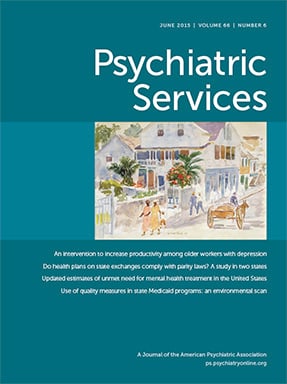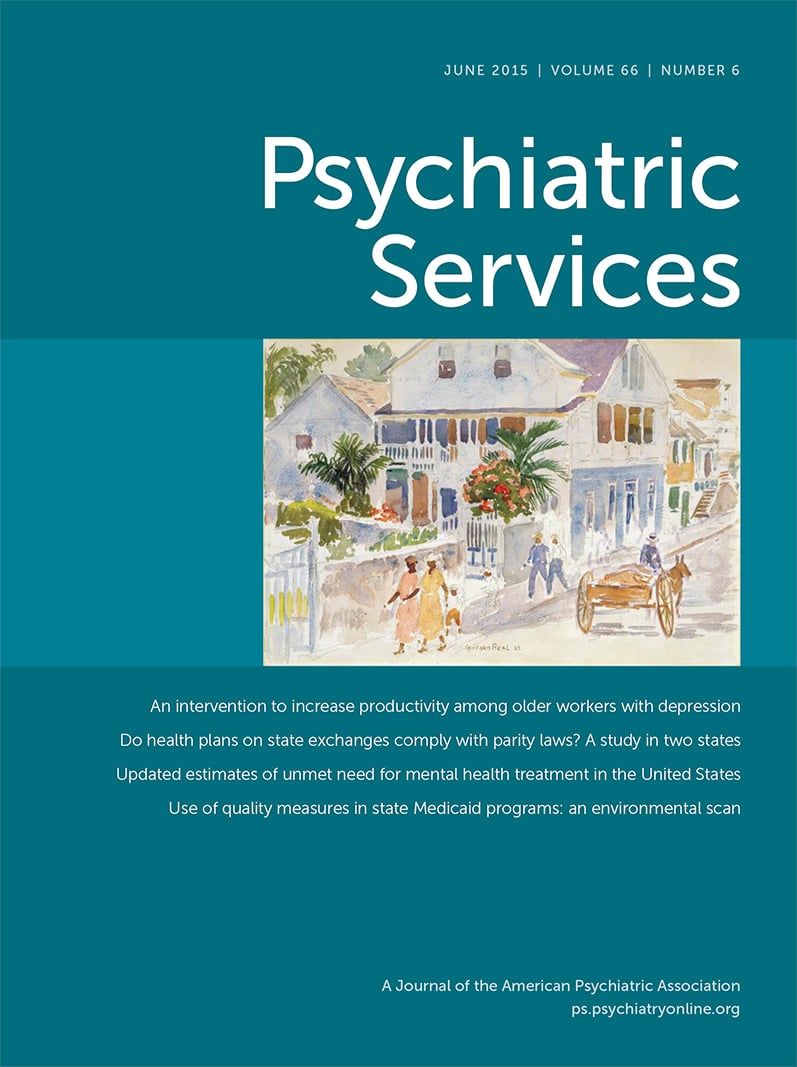The Affordable Care Act (ACA), in conjunction with the Paul Wellstone and Pete Domenici Mental Health Parity and Addiction Equity Act of 2008 (MHPAEA), is expected to expand coverage of mental health and substance use disorder services (referred to below as behavioral health services) with federal parity protections to more than 60 million Americans (
1). One main vector of this expansion is the ACA’s requirement that all plans and policies in small business and individual private insurance markets offered on the health insurance exchanges cover behavioral health care at parity, as defined by MHPAEA requirements, starting in January 2014. This should have the effect of bringing insurance products offered on exchanges into line with group commercial insurance products that have been required to comply with comprehensive parity since 2010 under MHPAEA. The intent of the 2008 law was to eliminate discriminatory practices in behavioral health insurance benefit design and to reduce wasteful forms of competition resulting from concerns about adverse selection (
2). Concerns remain, however, that issuers still have an incentive on the exchanges to avoid enrolling individuals who use behavioral health services, because their care is more costly than average (
3).
After the first open enrollment period, there was a need to assess how health plans offering products on the new exchanges were complying with the requirements of MHPAEA. In this column, we aim to open the dialogue by presenting an analysis of parity compliance in a narrow set of dimensions readily observable to consumers shopping on two state-run exchanges. Our focus is on how consumers would view the benefit information presented to them at the point of plan selection, and how indicators of apparent discrepancy with federal parity may affect plan enrollment decisions among consumers interested in accessing behavioral health treatment.
Health Plan Document Review Methods
We reviewed summaries of benefits documents available to potential enrollees for all insurance products offered on two state-run exchanges during the first open enrollment period from October 2013 through March 2014. The exchanges were selected for variety in health insurance issuers and products and ease of access to summary documents for all insurance products. We assessed instances of apparent inconsistency with MHPAEA requirements in observable dimensions of quantitative and nonquantitative treatment limitations, referencing the interim final regulations and final regulations and the guidance documents released by the Department of Labor (
4–
7). Specifically, for each product we assessed whether the quantitative treatment limitations (for example, cost sharing, deductibles, and visit limits) described for behavioral health benefits appeared more restrictive than the limitations described for the medical-surgical benefits in each of four classifications of benefits: outpatient in network, outpatient out of network, inpatient in network, and inpatient out of network.
With regard to parity in nonquantitative treatment limitations, several dimensions of compliance are not observable, because summary documents do not provide information on how medical management protocols (for example, provider network admission standards, fee schedules, step therapy protocols, and medical necessity determinations) are applied to covered benefits. However, we were able to observe one dimension of compliance in nonquantitative treatment limitation requirements for products in our sample: the imposition of a prior authorization requirement on behavioral health or medical-surgical benefits in inpatient and outpatient benefit classifications. In addition to noting inconsistencies with federal parity in these observable dimensions, where benefits appeared equitable we summarized characteristics of the benefit design that signaled compliance.
Our methods precluded conducting a full parity compliance analysis, which must take into account several other dimensions unreported in summary documents. However, we limited our analysis to the benefits information presented to consumers in an effort to emphasize the potential impact of these factors for consumer enrollment decisions. Consumers select a plan based on their anticipated service needs by using the written coverage information provided through the exchanges. Benefit design information suggesting unequal requirements and limitations for behavioral health services relative to other medical services may affect plan choice decisions among consumers who expect to use behavioral health services.
Exchange Analysis Results
Compliance in Observable Dimensions of Parity Varies by State
For 75% of products offered on both state exchanges, quantitative treatment limitations and prior authorization requirements described for behavioral health benefits appeared equivalent to or, in a few cases, more generous than those described for medical-surgical benefits. However, different pictures emerged for each of the two states. There was a fivefold difference in the number of products offered on one exchange versus the other. On the smaller exchange, a potential enrollee could expect to encounter products that appeared inconsistent with parity law more than half of the time, especially products with discrepancies in prior authorization requirements for behavioral health versus medical-surgical benefits. In contrast, on the larger exchange, a potential enrollee could expect to encounter apparent inconsistencies with the parity law less frequently but would be more likely to encounter a benefit description that appeared inconsistent with the financial requirements of parity than would an enrollee on the smaller exchange. This suggests that indicators of inconsistencies with parity law may manifest in patterns that vary from state to state.
Apparent Discrepancies in Quantitative Treatment Limit Requirements
The first observable area of discrepancy with federal parity concerns the type of financial requirements (that is, copayment, coinsurance, and deductible) imposed on behavioral health benefits versus medical-surgical benefits. For example, in one product, inpatient medical-surgical stays at out-of-network providers require a copayment, whereas inpatient behavioral health stays at out-of-network providers require coinsurance, which typically results in a higher total out-of-pocket payment than a copayment. [A table with language from benefit documents illustrating each discrepancy is available in an online supplement to this column.] We observed this kind of discrepancy occurring, albeit infrequently, in products offered on both states’ exchanges, affecting in-network and out-of-network benefit categories for inpatient and outpatient services.
We also noted an apparent discrepancy in the application of financial requirements to mental health versus substance abuse benefits. In one product, for example, outpatient in-network primary care and mental health visits were combined for the purpose of exempting the first three visits of either kind from the plan deductible. In comparison, outpatient in-network substance abuse treatment remained subject to the plan deductible from the first visit. Such a benefit design may cause the plan to appear less inviting to potential enrollees who intend to use outpatient substance abuse services, raising concerns about plan selection.
A third area of discrepancy occurred exclusively on the larger state’s exchange, where 11% of products impermissibly matched the financial requirements for outpatient in-network behavioral health visits to financial requirements for outpatient surgical visits, rather than to a reference category of general medical office visits. Although subdivision of outpatient services into office visits and other benefits (for example, outpatient surgical visits) is permitted under parity law and under the interim and final regulations, a comparable subdivision process must be carried out for outpatient behavioral health services in order to apply appropriate financial requirements (
5,
6). In the pattern we noted, all outpatient behavioral health services appear to be treated on par with the outpatient surgical benefit, which raises concerns about plan selection. Coverage for surgical visits is often more restrictive than for medical visits, so exchange plans that peg their behavioral health benefits to surgical visits may appear less generous to potential enrollees than competitor plans that peg their behavioral health benefits to medical visits. This discrepancy with the parity law may therefore have the effect of encouraging individuals with behavioral health treatment needs to choose a different exchange plan.
Apparent Discrepancies in Nonquantitative Treatment Limit Requirements
As noted above, the prior authorization requirement for behavioral health or medical-surgical benefits was one aspect of compliance with regard to nonquantitative treatment limitations that we observed. Because the processes and evidentiary standards used by issuers to apply these prior authorization requirements are not explicit in the summary documents, we employed a narrow measure of parity in this dimension, flagging only plans whose language suggested that prior authorization requirements are imposed automatically on all behavioral health benefits in a manner inconsistent with the requirements of parity law and guidance issued by the Department of Labor (
6). Even using this narrow criterion, we noted several apparent instances of noncompliance with regard to prior authorization occurring in the outpatient benefit classification for products in our sample.
For several health plan products, summary documents specified prior authorization as a requirement for all outpatient behavioral health visits. In contrast, for these same products, prior authorization was either not specified at all as a requirement for outpatient medical-surgical benefits or specified as a requirement that would be selectively applied to certain services in the medical-surgical category. This inconsistent use of prior authorization appeared most often (although not exclusively) on the smaller exchange and was an issue for nearly three-quarters of products on that exchange. There are several possible explanations for the apparent inconsistencies with federal parity law related to prior authorization exhibited in summary documents. For example, issuers may be erroneously interpreting behavioral health as a subspecialty on par with other prior authorization–limited subspecialties in the medical-surgical service category (for example, outpatient radiology or rehabilitative services), rather than as a defined category on par with medical-surgical benefits.
Conclusions
Characterizing the consumer experience of parity at the point of plan selection is only one step toward addressing broader questions of health plan compliance with MHPAEA regulations. A follow-up study taking into consideration the disclosure and transparency requirements detailed in the final regulations is essential to extend and update the analysis presented here (
5).
Some of the apparent inconsistencies with parity law we noted were accentuated by the historical practice of separating the behavioral health benefit from the medical-surgical benefit in summaries of benefits available to consumers, which occurs throughout most commercial insurance and has persisted on the new exchanges. Separating out the behavioral health benefit may serve an important role in reassuring consumers that behavioral health services are covered. This is especially true for plans on the individual market, which have lagged behind small group and employer-sponsored plans in offering any behavioral health benefit (
8–
10). Yet, as our analysis suggests, splitting out behavioral health benefits in plan documents may also lead to an impression that behavioral health is being treated differently than other service areas. Notably, one issuer in our analysis chose to fully combine behavioral health and medical-surgical benefits in its summary documents, and this approach could be a good option for other health plans that wish to communicate equitable treatment of the behavioral health benefit to consumers.
Although these potential inconsistencies with parity law are subtle, they illustrate concerns and policy questions that may warrant exploration in other state exchanges. The ACA offers substantial opportunities for broadening access to behavioral health insurance, including through the application of parity to the new exchanges. Moving forward, it will be critical to monitor whether these regulations are fulfilling their promise to increase fairness and efficient operation of the insurance market.

